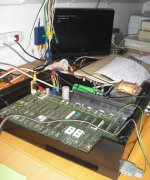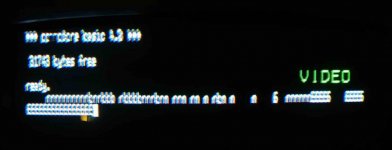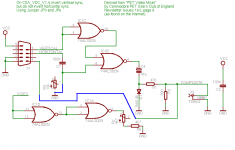crock
Experienced Member
Gents,
My preferred way to work on PET boards is to have the board out of the machine and hooked up to a bench supply and a small LCD monitor. This is easy using one of Matthew D'Asaro's composite adapters but they only work on the old non-CRTC PET's. They don't work on CRTC based PET's. Now, after a bit of hacking I finally managed to get a great picture on a modern LCD.
There’s three problems. First the horizontal sync pulse needs to be inverted. On a 2001 it's a positive and thus what the internal 9" monitors and the adapter expects. The 6545 also generates positive sync pulses but a standard NTSC or PAL composite signal uses a negative pulse, as do all the internal monitors in CRTC PET's I have seen, so the signal is inverted by a 74LS86 quad XOR gate at UC2. Thoughtfully, Commodore provided a couple of unmarked jumpers on the board next to UC2 to allow you to flip the polarity of both pulses. They are marked on the schematics as J1 and J2 and pull one input of an XOR gate high or low. I cut the trace to +5 and jumped it to ground, thus giving the positive pulse. No problem with the vertical sync as it’s consistently a negative pulse generated by all PET’s, although you *could* flip that with the other jumper next to UC2 if required.
Second problem is with the video signal itself, which on the 2001 is inverted (low = white, high = black), so the composite adapter inverts it again. The video signal from the CRTC PET's is already the correct polarity so I simply bypassed the NOR gate on the adapter.
Finally, the typical CRTC configuration from the EDIT ROM will not give a viewable picture on most TV’s or monitors. The standard edit ROM CRTC configurations generate a frame rate of 50 or 60 Hz, in line with the ‘local’ frequency and standards, but a horizontal frequency of 20 kHz, which is way outside the 15.625khz standard PAL horizontal frequency. Looking at all the ROMS on zimmers.net, there was one (edit-4-80-b-50Hz.901474-04_.bin) which had been modified to create the correct horizontal frequency by adjusting the number of horizontal characters. I burnt this to an EPROM and now I have a great monochrome picture on my cheap LCD TV which is quite readable in 80 columns.
The next step is to build a new version of Matthew's board which allows you to bypass the inversion of the h-sync and video signals via a jumper.
cheers, Rob


My preferred way to work on PET boards is to have the board out of the machine and hooked up to a bench supply and a small LCD monitor. This is easy using one of Matthew D'Asaro's composite adapters but they only work on the old non-CRTC PET's. They don't work on CRTC based PET's. Now, after a bit of hacking I finally managed to get a great picture on a modern LCD.
There’s three problems. First the horizontal sync pulse needs to be inverted. On a 2001 it's a positive and thus what the internal 9" monitors and the adapter expects. The 6545 also generates positive sync pulses but a standard NTSC or PAL composite signal uses a negative pulse, as do all the internal monitors in CRTC PET's I have seen, so the signal is inverted by a 74LS86 quad XOR gate at UC2. Thoughtfully, Commodore provided a couple of unmarked jumpers on the board next to UC2 to allow you to flip the polarity of both pulses. They are marked on the schematics as J1 and J2 and pull one input of an XOR gate high or low. I cut the trace to +5 and jumped it to ground, thus giving the positive pulse. No problem with the vertical sync as it’s consistently a negative pulse generated by all PET’s, although you *could* flip that with the other jumper next to UC2 if required.
Second problem is with the video signal itself, which on the 2001 is inverted (low = white, high = black), so the composite adapter inverts it again. The video signal from the CRTC PET's is already the correct polarity so I simply bypassed the NOR gate on the adapter.
Finally, the typical CRTC configuration from the EDIT ROM will not give a viewable picture on most TV’s or monitors. The standard edit ROM CRTC configurations generate a frame rate of 50 or 60 Hz, in line with the ‘local’ frequency and standards, but a horizontal frequency of 20 kHz, which is way outside the 15.625khz standard PAL horizontal frequency. Looking at all the ROMS on zimmers.net, there was one (edit-4-80-b-50Hz.901474-04_.bin) which had been modified to create the correct horizontal frequency by adjusting the number of horizontal characters. I burnt this to an EPROM and now I have a great monochrome picture on my cheap LCD TV which is quite readable in 80 columns.
The next step is to build a new version of Matthew's board which allows you to bypass the inversion of the h-sync and video signals via a jumper.
cheers, Rob


Last edited:


